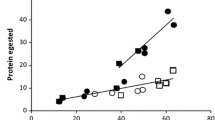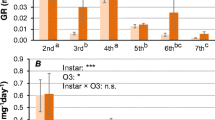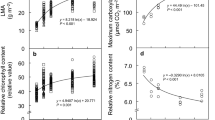Summary
Hyalophora cecropia larvae were reared on leaves of wild cherry,Prunus serotina, which contained variable amounts of leaf water but otherwise did not differ in fiber, total nitrogen, and caloric content. Larvae which were fed leaves low in leaf water grew more slowly and were less efficient at utilizing plant biomass, energy, and nitrogen than those larvae fed leaves which were fully supplemented with water.
Experiments were performed using excised leaves under different regimes of relative humidity and leaf water supplementation in climatic control chambers maintained at identical temperatures and photoperiod. Foodplant biomass utilization efficiencies were severely reduced by decreasing amounts of leaf water. Growth rates were halved and the efficiency of conversion of assimilated dry matter into larval biomass was reduced from 82% in the treatment with fully supplemented leaves to 34% in the driest treatment. The nitrogen utilization efficiency (N.U.E.) was reduced from 75–80% to 48%, and the relative accumulation rate of nitrogen (N.A.R.) was suppressed nearly 2-fold for larvae on low-water leaves. Relative maintenance costs (calories expended in respiration/mg tissue/day) of larvae were nearly five times higher on dry leaves than on fully supplemented leaves. Larvae on leaves which were low in water content were themselves more desiccated, and metabolized greater portions of assimilated energy, perhaps in an attempt to supplement body water with metabolic water derived from respiration.
The larval rates of consumption of biomass, energy, and nitrogen were the same for all treatments, indicating that leaf water affected larval growth primarily by restricting the efficiency of utilizing these nutrients. Where water was limiting (as in tree leaves), an increased consumption rate did not appear to be a successful means of increasing growth rates. There were daily and seasonal differences in leaf water content between different trees of the same species. Although absolute differences in leaf water exist between different trees and between young and old (fully expanded) leaves of a single tree, these differences are proportional and parallel each other through daily and seasonal cycles.
In spite of evolutionary adaptations of herbivores to acquire adequate water and avoid desiccation, the leaf water content naturally encountered by cecropia larvae on cherry leaves may limit their growth, especially if the R.H. is low.
Similar content being viewed by others
References
Ahmad, T.: The influence of ecological factors on the Mediterranean Flour Moth,Ephestia kuhniella, and its parasite,Nemeritis canescens. J. animal Ecol.5, 67–93 (1936)
Arlian, L.G.: Water exchange and effect of water vapour activity on metabolic rate in the dust mite,Dermatophagoides. J. Insect Physiol.21, 1439–1442 (1975)
Arlian, L.G., Eckstrand, I.A.: Water balance inDrosophila pseudoobscura, and its ecological implications. Ann. entomol. Soc. Amer.68, 827–832 (1975)
Arlian, L.G., Wharton, G.W.: Kinetics of active and passive components of water exchange between the air and a mite,Dermatophagoides farine. J. Insect Physiol.20, 1063–1077 (1974)
Barton-Browne, L.: Water regulation in insects. Ann. Rev. Entomol.9, 63–82 (1964)
Barton-Browne, L.: Regulatory mechanisms in insect feeding. Adv. Insect Physiol.11, 1–116 (1975)
Beament, J.W.L.: The water relations of insect cuticle. Biol. Rev.36, 281–320 (1961)
Beament, J.W.L.: The active transport and passive movement of water in insects. Advan. Insect Physiol.2, 67–129 (1964)
Berridge, M.J.: Osmoregulation in terrestrial arthropods. In: Chemical zoology, Vol. 5 (M. Florkin, B.T. Scheer, eds.), pp. 287–319. New York: Academic Press 1970
Buck, J.B.: The internal environment in regulation and metamorphosis. In: Insect physiology (K.D. Roeder, ed.), pp. 191–208. New York: Wiley 1953
Bursell, E.: An introduction to insect physiology, 276 pp. New York: Academic Press 1970
Candy, D.J., Kilby, B.A.: Insect biochemistry and function, 1st ed., pp. 182–209 London: Chapman and Hall; New York; Wiley 1975
Cates, R.G., Orians, G.H.: Successional status and the palatability of plants to generalized herbivores. Ecology56, 410–418 (1965)
Cloudsley-Thompson, J.L.: Microclimates and the distribution of terrestrial arthropods. Ann. Rev. Entomol.7, 199–222 (1962)
Cloudlsey-Thompson, J.L.: Terrestrial animals in dry desert heat: Arthropods. Adapt. Environ.4, 451–465 (1964)
Cloudsley-Thompson, J.L.: Adaptations of Arthropoda to arid environments. Ann. Rev. Entomol.20, 261–283 (1975)
Edney, E.B.: The water relations of terrestrial arthropods, 109 pp. Cambridge, England: Cambridge University Press 1957
Edney, E.B.: Absorption of water vapour from unsaturated air byArenivaga sp. (Polyphagidae, Dictyoptera). Comp. Biochem. Physiol.19, 387–408 (1966)
Evans, A.C.: The utilization of food by certain Lepidopterous larvae. Trans. roy. entomol. Soc. London89, 13–22 (1939)
Feeny, P.P.: Seasonal changes in oak leaf tannins and nutrients as a cause of Spring feeding by Winter moth caterpillars. Ecology51, 565–581 (1970)
Feeny, P.P.: Biochemical coevolution between plants and their insect herbivores. In: Coevolution of animals and plants, Symposium at 1st Intern. Cong. Syst. and Evol. Biol. (August 1973) (L.E. Gilbert, P.H. Raven, eds.), pp. 3–19. Austin: Univ. Texas Press 1975
Feeny, P.P.: Plant apparency and chemical defense. In: Biochemical interactions between plants and insects (J. Wallace, R. Mansell, eds.). Recent Adv. Phytochem.10, 1–40 (1976)
Ferguson, D.C.: Bombycoidea: Saturniidae (In Part). In: The moths of America North of Mexico (R.B. Dominick, ed.), pp. 246–251 London: Classey 1972
Fogel, W.H.: Nutritive value of pine foliage for some Diprionid sawflies. Proc. entomol. Soc. Ontario105, 101–118 (1974)
Forbes, W.T.M.: The Lepidoptera of New York and neighboring states (Part 4). Cornell University Agr. Expt. Sta. Memoir68 (1969)
Fraenkel, G., Blewett, M.: The utilization of metabolic water in insects. Bull. entomol. Res.35, 127–139 (1944)
Futuyma, D.J.: Foodplant specialization and environmental predictability in Lepidoptera. Amer. Natur.110, 285–292 (1976)
Guha, M.M., Mitchell, R.L.: The trace and major element composition of the leaves of some deciduous trees, II, Seasonal changes. Plant Soil24, 90–112 (1966)
Holdaway, F.G.: An experimental study of the growth of populations of the “Flour beetle”,Tribolium confusum (Duval), as affected by atmospheric moisture. Ecol. Monogr.2, 261–304 (1932)
Kanungo, K.: Oxygen uptake in relation to water balance of a mite (Echinolaelaps echidninus) in unsaturated air. J. Insect Physiol.11, 557–568 (1965)
Kozlovsky, D.: A critical evaluation of the trophic level concept. Ecological efficiencies. Ecology49, 48–60 (1968)
Likens, G.E., Bormann, F.H.: Chemical analyses of plant tissues from the Hubbard Brook ecosystem in New Hampshire. Yale University School of Forestry Bull. No. 79 (1970)
McKenzie, H.H., Wallace, H.S.: The Kjeldahl determination of nitrogen: a critical study of digestion conditions-temperature, catalyst, and oxidizing agent. Aust. J. Chem.7, 55–70 (1954)
McHargue, J.S., Roy, W.R.: Mineral and nitrogen content of the leaves of some forest trees at different times in the growing season. Bot. Gazette94, 381–393 (1932)
Mellanby, K., French, R.A.: The importance of drinking water to larval insects. Entomol. Expt. Appl.1, 116–124 (1958)
Murray, D.R.P.: The importance of water in the normal growth of larvae ofTenebrio molitor. Entomol. Expt. Appl.11, 149–168 (1968)
Pandian, T.J., Delvi, M.R.: Energy extraction efficiency in some chosen insects. Oecologia (Berl.)13, 397–401 (1973)
Phillipson, J.: A miniature bomb calorimeter for small biological samples. Oikos15, 130–139 (1964)
Rhoades, D.F., Cates, R.G.: Toward a general theory of plant antiherbivore chemistry. In: Biochemical interactions between plants and insects (J. Wallace, R. Mansell, eds.). Recent Adv. Phytochem.10, 168–213 (1976)
Rudolfs, W.: Studies on chemical changes during the life cycle of the tent caterpillar (Malacosoma americana Fabr.). Part I. Moisture and fat. J. New York entomol. Soc.34, 249–256 (1926)
Scarbrough, A.B.: The occurrence ofHyalophora cecropia (L.) as related to urbanization. Ph.D. thesis, 217 pp., Univ. Illinois at Urbana-Champaign (1970)
Scarbrough, A.G., Waldbauer, G.P., Sternburg, J.G.: Feeding and survival ofcecropia (Saturniidae) larvae on various plant species. J. Lepid. Soc.28, 212–219 (1974)
Schmidt-Nielson, K.: Animal physiology, 715 pp. New York: Cambridge Univ. Press 1975
Scriber, J.M.: Comparative nutritional ecology of herbivorous insects: Generalized and specialized feeding strategies in the Papilionidae and Saturniidae (Lepidoptera). Ph. D. thesis, 289 pp., Ithaca, N.Y., Cornell University (1975)
Sharada, K., Bhat, J.V.: Seasonal variation in the growth of, and silk production by the silkworm,Bombyx mori, L. J. Indian Inst. Sci.39, 49–55 (1957a)
Sharada, K., Bhat, J.V.: Influence of humidity on feed utilization by the silkworm,Bombyx mori L. J. Indian Inst. Sci.39, 220–223 (1957b)
Slansky, F. Jr.: Energetic and nutritional interactions between larvae of the imported cabbage butterflyPieris rapae L., and cruciferous foodplants, Ph.D. Thesis, Ithaca, N.Y., Cornell University (1974a)
Slansky, F. Jr.: Relationship of larval food-plants and voltinism patterns in temperate butterflies. Psyche81, 243–253 (1974b)
Slansky, F., Feeny, P.P.: Maximization of the rate of nitrogen accumulation by larvae of the cabbage butterfly on wild and cultivated food plants. Ecol. Monogr. (in press, 1977)
Smirnov, V.V., Semenova, V.G.: Seasonal changes in the contents of ash elements in leaves of birch and aspen. Ekologiya2, 91–92 (1972)
Snedecor, G.W., Cochran, W.G.: Statistical methods, 6th ed. 591 pp. Ames, Iowa: Iowa State Univ. Press 1967
Soo Hoo C.F., Fraenkel, G.: The consumption, digestion, and utilization of foodplants by a polyphagous insect,Prodenia eridania (Cramer). J. Insect Physiol.12, 711–730 (1966)
Southwood, T.R.E.: The insect/plant relationship—an evolutionary perspective. In: Insect/plant relationships (H.F. Van Emden, ed.), pp. 3–30. London: Blackwell 1972
Speicher, B.R.: The effects of desiccation upon the growth and development of the Mediterranean Flour moth. Proc. Pa. Acad. Sci.5, 79–82 (1931)
Srivastava, P.B.L.: Seasonal variation of nutrient content in the leaves of Sal (Shorea robusta) tree and seedlings. J Indian Bot. Soc.44, 429–438 (1965)
Sternburg, J.G., Waldbauer, G.P.: Bimodal emergence of adult cecropia moths under natural conditions. Ann. entomol. Soc. Amer.62, 1422–1429 (1969)
Tamm, C.O.: Seasonal variation in composition of birch leaves. Physiol. Plant.4, 461–469 (1951)
Waldbauer, G.P.: The growth and reproduction of maxillectomized tobacco hornworms feeding on normally rejected non-solanaceous plants. Entomol. Expt. Appl.5, 147–158 (1962)
Waldbauer, G.P.: The consumption, digestion, and utilization of solanaceous and non-solanaceous plants by larvae of the tobacco hornworm,Protoparce sexta (Johan) (Lepidoptera: Sphingidae). Entomol. Expt. Appl.7, 253–269 (1964)
Waldbauer, G.P.: The consumption and utilization of food by insects. Adv. Insect Physiol.5, 229–289 (1968)
Waldbauer, G.P., Sternburg, J.G.: Host plants and the locations of baggy and compact cocoons ofHyalophora cecropia (Lepidoptera: Saturniidae). Ann. entomol. Soc. Amer.60, 97–101 (1967)
Waldbauer, G.P., Sternburg, J.G.: Polymorphic termination of diapause by cecropia: genetic and geographic aspects. Biol. Bull.145, 627–641 (1973)
Wharton, G.W., Arlian, L.G.: Utilization of water by terrestrial mites and insects. In: Insect and mite nutrition (J.G. Rodriquez, ed.), pp. 153–165. Amsterdam: North Holland 1972
Wharton, G.W., Devine, T.L.: Exchange of water between a mite,Laelaps echidnina, and the surrounding air under equilibrium conditions. J Insect Physiol.14, 1301–1318 (1968)
Woodwell, G.M.: Variation in the nutrient content of leaves ofQuercus alba, Quercus coccinea andPinus rigida in the Brookhaven Forest from bud-break to abscission. Amer. J. Bot.61, 749–753 (1974)
Woodwell, G.M., Whittaker, R.H., Houghton, R.A.: Nutrient concentrations in plants in the Brookhaven oak-pine forest. Ecology56, 318–332 (1975)
Wigglesworth, V.B.: The principles of insect physiology, 6th ed. 741 pp. London: Methuen 1965
Author information
Authors and Affiliations
Rights and permissions
About this article
Cite this article
Scriber, J.M. Limiting effects of low leaf-water content on the nitrogen utilization, energy budget, and larval growth ofHyalophora cecropia (Lepidoptera: Saturniidae). Oecologia 28, 269–287 (1977). https://doi.org/10.1007/BF00751605
Received:
Issue Date:
DOI: https://doi.org/10.1007/BF00751605




